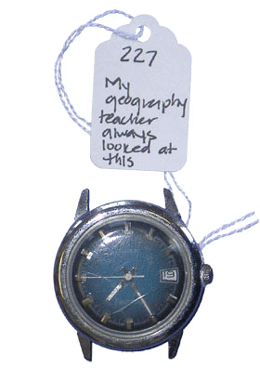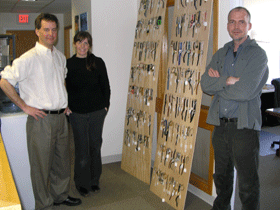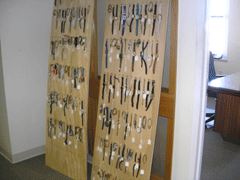Retiring the Wrist Watch
Air Date: Week of May 1, 2009

Watch number 227 of the Thousand Watch Project.
Once upon a time, there were wristwatches but their time has come and gone. Cellphones have made watches passé but, as Living on Earth's Bruce Gellerman reports, The Thousand Watch Project hopes to preserve them...for all time.
Transcript
CURWOOD: “Time present and time past are both perhaps present in time future,” writes the poet TS Eliot – and an architectural firm in Boston couldn’t agree more.
They’re designing a preserve for an artifact that is rapidly becoming an anachronism – the wristwatch.
Living on Earth’s Bruce Gellerman has our story.
GELLERMAN: Boston based Moskow Linn Architects specialize in creating buildings for environmental organizations. No question business has been slow lately, but things perk up when its time to open the mail. Today partner Keith Moskow gives a visitor the honor.
MOSKOW: Why don’t you open that? We don’t know what’s in it.

Keith Moskow, Sarah West, Robert Linn(left-right).
GELLERMAN: Well this is exciting.
MOSKOW: It is – it’s the excitement each day. What shows up in the mail.
[MORE OPENING SOUNDS]
GELLERMAN: Moskow Linn Architects receive a lot of packages these days: stacks of brown boxes and beige envelopes.
It comes with a little bubble wrap here.
[BUBBLE WRAP AND OPENING SOUNDS]
MOSKOW: Whoa.
GELLERMAN: Whoa.
MOSCOW: Whoa.
GELLERMAN: A trove! I think you’re over -
MOSKOW: A treasure trove!
GELLERMAN: Look at this
[WRINKLING OF PACKAGING]
GELLERMAN: Oh my gosh, somebody sent you – watches. Lots and lots of wristwatches.
Large and small, digital and analogue. Some with bands, some without. Each watch in this box has a small tag with a short, neatly written message which Keith Moskow reads.
MOSKOW: Cool purchase quickly became fashion don’t. I begged my grandma for this. I wore it only once. Katie.
[WRINKLING OF PACKAGING]
MOSKOW: She had a lot of watches here. [Laughing] Received at the age six but I couldn’t tell time.
[WRINKLING OF PACKAGING AND LAUGHING]
MOSKOW: I’m sure Katie uses her cell phone now.
[WRINKLING OF PACKAGING]
GELLERMAN: And so do many people. The times are a-changing and how we tell time is also changing.
MOSKOW: If you think about it, most people under the age of twenty-five do not where a wristwatch. They use their cell phone. And so arguably the wristwatch will go the same way as a pocket watch, so this is a moment in time, this changing, this time period when we’re switching over.
GELLERMAN: To preserve the past and mark the time when people wore wristwatches, Moskow Linn architects have created what they call the Thousand Watch Project.

The watch collection thus far. (Photo Bruce Gellerman)
GELLERMAN: What does the Smithsonian say about this? Have you approached them yet?
MOSKOW: We have sent and inquiry letter as you do and we’re waiting to hear what they say. We’re sending it to them either way, anyway.
GELLERMAN: Then it’s their problem.
MOSKOW: Yeah
[LAUGHING]
MOSKOW: But we’re going to pack it up because it really becomes a time capsule.
GELLERMAN: The Thousand Watch Project began modestly with a notice on Craigslist, but clearly it’s an idea who’s time has come says architect Robert Linn.
LINN: Here’s something we’ve identified as kind of a cultural phenomenon, that people have all these watches, you can’t throw them away. Maybe its because you where them so close to your skin, maybe its because it’s the one item of clothing or object that you wear every single day for a short period of time. You then switch it out for another one. So it sort of marks different periods of time in people’s lives. So we didn’t know exactly what we were gonna do with them, but we just started collecting them to see where it would lead. And it turns out that that really resonated with a lot of people.
MOSKOW: It wasn’t something we sat down and said “Oh, we’re just gonna do it.”
GELLERMAN: Again, architect Keith Moskow.
MOSKOW: I found that I had watches in my drawer that I just couldn’t get rid of. I had gotten a watch for a graduation present from college twenty-five years ago.
GELLERMAN: Everybody did.
MOSKOW: A couple years later, it went through the washing machine. I never told my mother until literally a couple of weeks ago. But it moved with me half a dozen times, even though it was a busted watch. It’s inscribed in the back. I couldn’t toss it out. I’d purchased my first Swatch when I was in architecture school, I was in Switzerland. Once again, it turned yellow I wore it so long. It was a clear watch, couldn’t toss it out. And Rob and I were chatting one day and we realized that he had a bunch of watches too that he had never tossed out. So we go okay, well, let’s bring them to work, we’ll sort of get them out of the sock draw, put them somewhere else.

Reporter Bruce Gellerman’s old watch.
WEST: 470 was recent donation and the epitaph that was sent in with it said for Sergeant Rodney Murray, time just ran out. No other explanation was sent in.
MOSKOW: That’s very interesting because that watch came in, it was a fellow who used to work here, and he ran as a seeing-eye runner for someone in the New York marathon. He led somebody and he clicked it when he was done with his time – it was just over four hours.
GELLERMAN: Number 400.
WEST: Number 400 says, “You will always remind me of youth” from Shane Hughs. Yes, and this is one that was sent in from Australia.
GELLERMAN: This one. “You used to be my favorite. Not so much anymore.” These are like little gravestones, you know.
MOSKOW: They are. Well that’s the idea. It’s an epitaph, and it’s a way of just putting a couple of words. You only put a couple of words on a gravestone, and it’s just enough to tweak somebody’s imagination or memory.
GELLERMAN: So let me read a couple of these: “As time ran out, left in the second grade lost and found for two years.” Wisconsin.
MOSKOW: “Bought at our friend Cindy’s cancer fundraiser. RIP Cindy.”
GELLERMAN: So some of these really are from people who are no longer alive.
MOSKOW: Very well could be. I mean we’ve gotten watches from people who said they were parents’ and or grandparents’ watches and they just could not get rid of them. But here was an honorable way to – something honorable to do with it.
GELLERMAN: The watches are also photographed and Sarah West scans the picture onto the Thousand Watch Project website where they can be seen for all time.
WEST: I think it’s a nice bit that once they’re online, you can continue to visit it, you know as if you were opening the drawer, you remember it, you know, maybe, so you can still have a bit of that relationship, but I think people do entrust us to protect this memory and this keepsake and expect that we’ll treat it well. We try to.
GELLERMAN: Recently the Thousand Watch Project hit a milestone, the halfway mark. Architect Keith Moscow.
MOSCOW: This is number 500. And it says, “Treasure from the past. I love this watch. M.B.M.” Number 500. So this was a really important watch to receive.
GELLERMAN: Actually you guys are recycling time, you’re answering that age old question, what do you do with your old watch.
MOSCOW: And what do you do with your time?
GELLERMAN: Me? I sent two old watches in to the Thousand Watch Project, number 511 and 512.
For Living on Earth, I’m Bruce Gellerman.
[MUSIC: Easy All-Stars “Time” from Dub Side OF The Moon (Easy Star records 2003)]
CURWOOD: To check out the entire Thousand Watch Project collection and learn how you can donate your old watches, go to our web site: loe.org.
Links
Living on Earth wants to hear from you!
Living on Earth
62 Calef Highway, Suite 212
Lee, NH 03861
Telephone: 617-287-4121
E-mail: comments@loe.org
Newsletter [Click here]
Donate to Living on Earth!
Living on Earth is an independent media program and relies entirely on contributions from listeners and institutions supporting public service. Please donate now to preserve an independent environmental voice.
NewsletterLiving on Earth offers a weekly delivery of the show's rundown to your mailbox. Sign up for our newsletter today!
 Sailors For The Sea: Be the change you want to sea.
Sailors For The Sea: Be the change you want to sea.
 The Grantham Foundation for the Protection of the Environment: Committed to protecting and improving the health of the global environment.
The Grantham Foundation for the Protection of the Environment: Committed to protecting and improving the health of the global environment.
 Contribute to Living on Earth and receive, as our gift to you, an archival print of one of Mark Seth Lender's extraordinary wildlife photographs. Follow the link to see Mark's current collection of photographs.
Contribute to Living on Earth and receive, as our gift to you, an archival print of one of Mark Seth Lender's extraordinary wildlife photographs. Follow the link to see Mark's current collection of photographs.
 Buy a signed copy of Mark Seth Lender's book Smeagull the Seagull & support Living on Earth
Buy a signed copy of Mark Seth Lender's book Smeagull the Seagull & support Living on Earth

